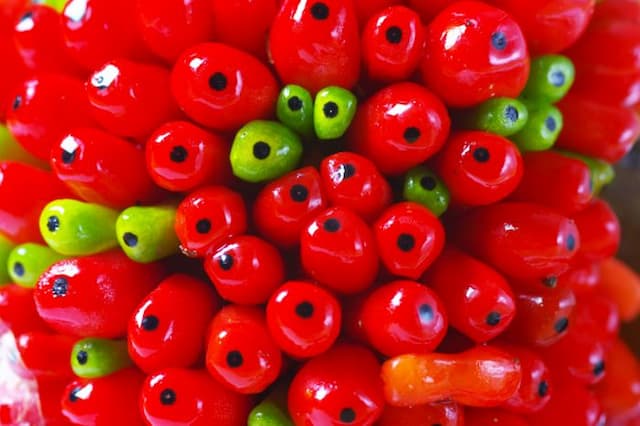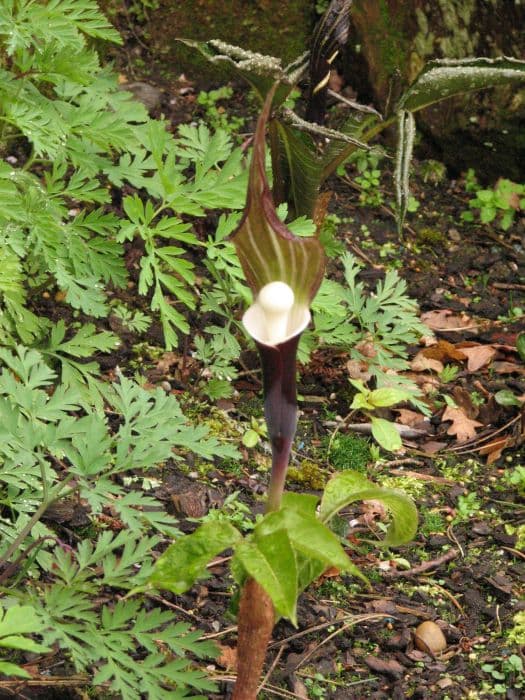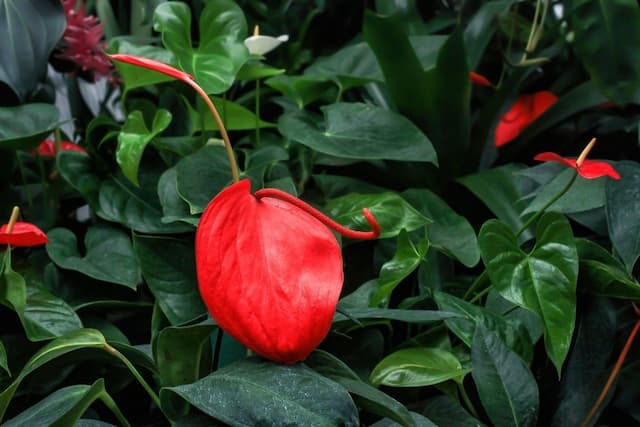Golden Club Orontium aquaticum
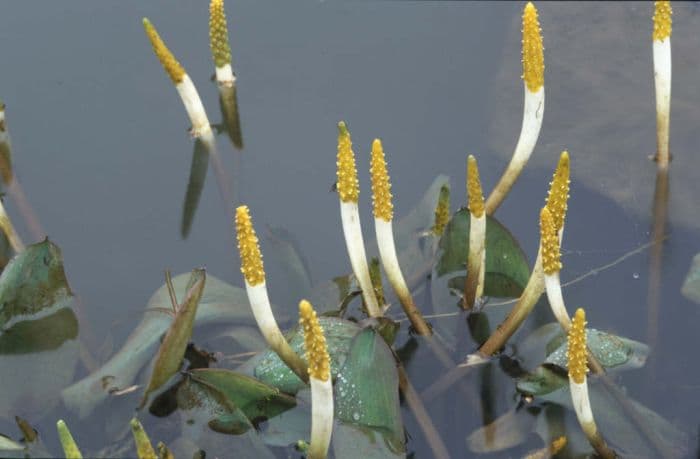

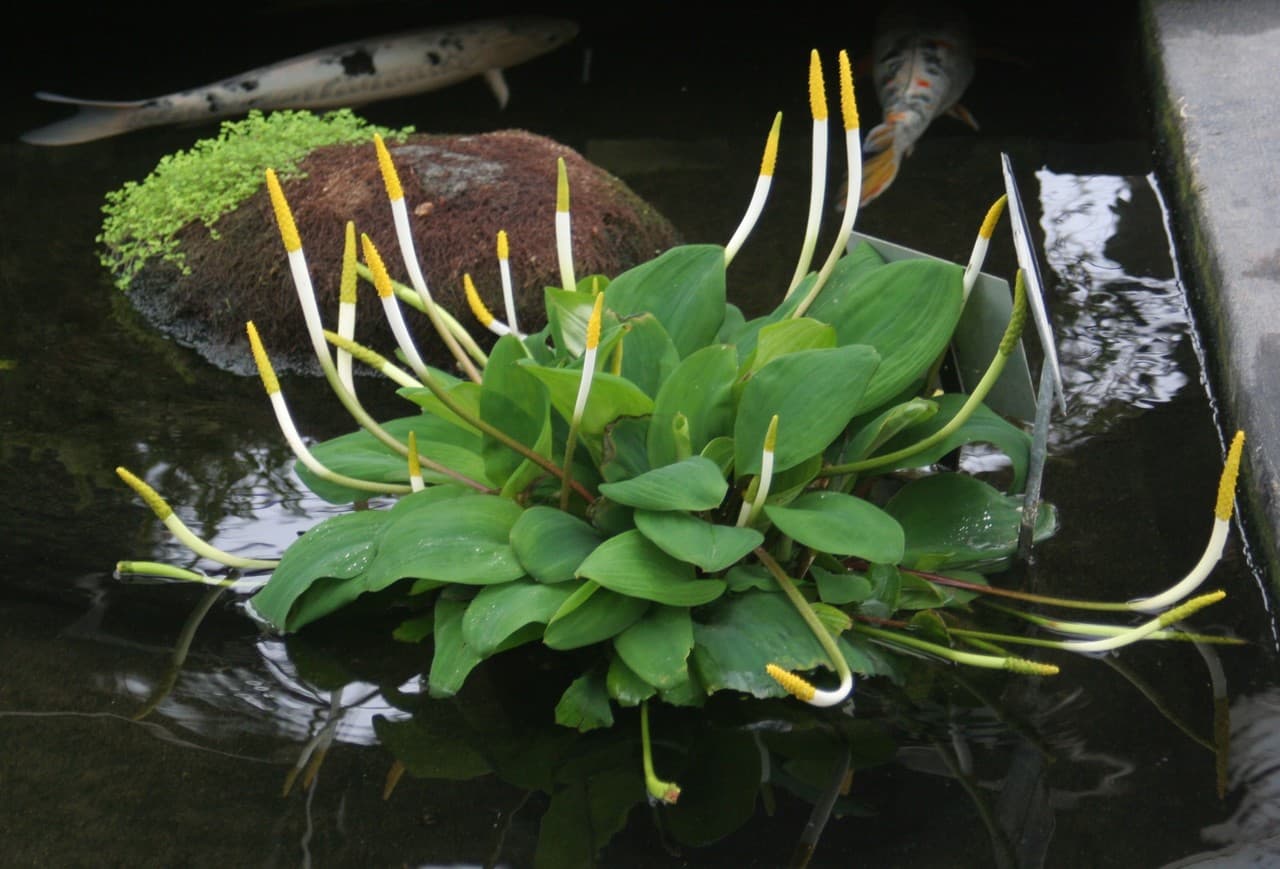
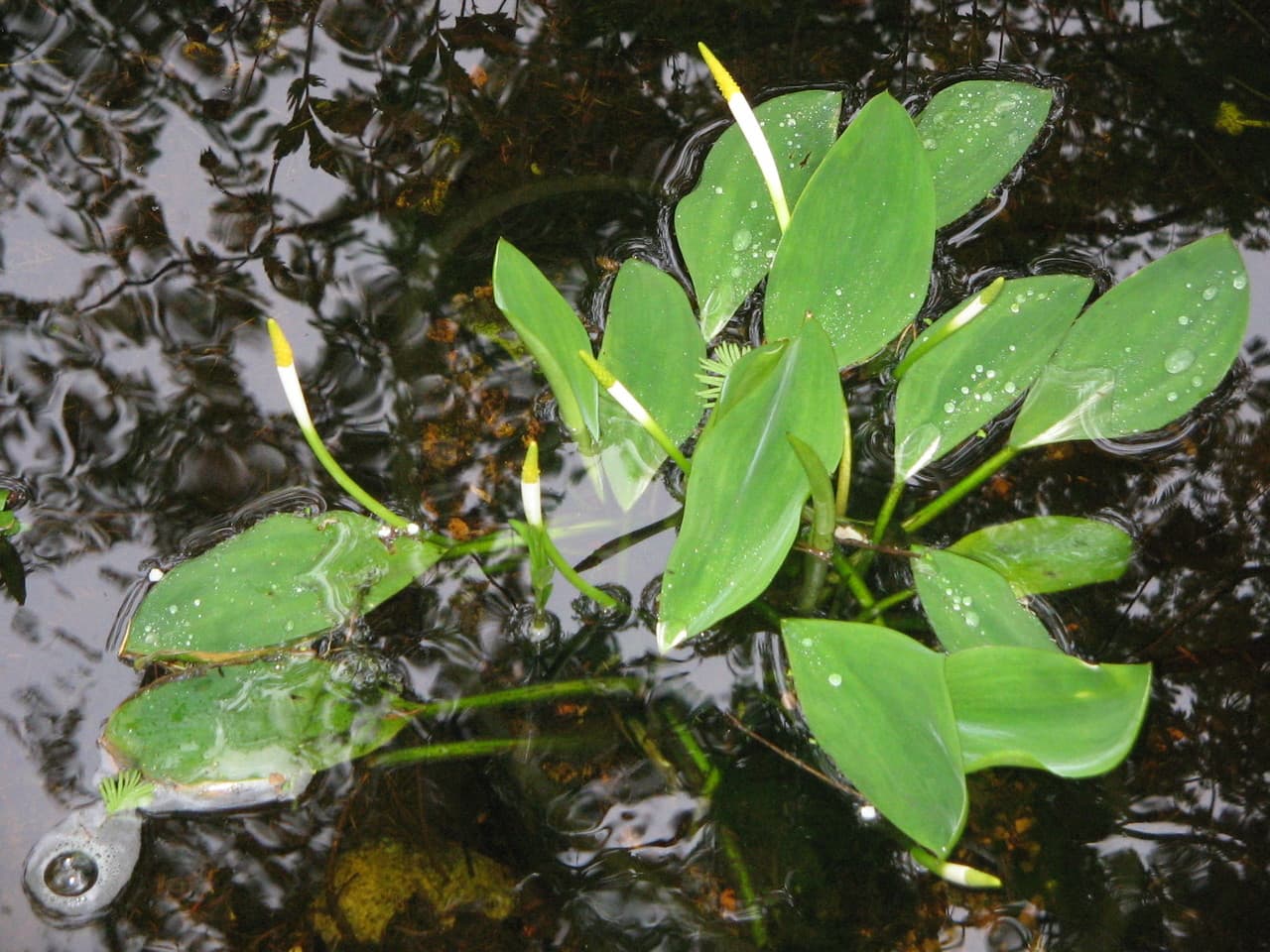


ABOUT
The plant commonly known as Golden Club has a distinctive and unique appearance that is recognized by its inflorescences and foliage floating or emerging from the water. The leaves are typically glossy and bright green in color, creating a striking contrast with the water's surface. They have an elongated, lance-shaped form that tapers towards the tip, and they often float on top of the water or extend slightly above it. The most striking feature of Golden Club is its flower spikes, which boast a bright yellow hue and give the plant its common name. These flower spikes are cylindrical and dense, covered in tiny blossoms that can provide an eye-catching display against the backdrop of the foliage. The overall visual effect of this plant is serene and attractive, making it a desirable addition to water gardens or natural aquatic settings. The stems of this aquatic plant are usually submerged, anchored in the muddy bottoms of ponds, slow-moving streams, or swamps where it typically grows. The underwater stems and roots are important for anchoring the plant but are generally not visible above the water level. The submerged parts contribute to the overall health and stability of the plant in its aquatic environment. Golden Club is a hardy plant that is well-suited to wetland habitats, and its mostly green palette, except for the golden flower spikes, allows it to blend into natural settings easily while still providing a pop of color. The combination of the plant's green leaves and golden flowers creates a simple yet striking appearance that draws attention and is particularly notable during its blooming season.
About this plant
 Names
NamesSynonyms
Golden Club, Floating Arum, Neverwet, Tawkin.
Common names
Orontium aquaticum L.
 Toxicity
ToxicityTo humans
Golden Club (Orontium aquaticum) is generally not known to be toxic to humans. There is no well-documented evidence of its toxicity upon ingestion. However, it is always advisable to refrain from eating any part of ornamental plants due to potential individual allergic reactions or gastrointestinal discomfort.
To pets
Similar to its effects on humans, Golden Club (Orontium aquaticum) is not widely recognized as a toxic plant to pets. There are no common reports of poisoning in animals such as dogs and cats from ingestion of this plant. Nonetheless, pet owners should discourage pets from chewing on any ornamental plants to prevent any possible adverse reactions.
 Characteristics
CharacteristicsLife cycle
Perennials
Foliage type
Evergreen
Color of leaves
Green
Flower color
Yellow
Height
1-2 feet (30-60 cm)
Spread
1-2 feet (30-60 cm)
Plant type
Herb
Hardiness zones
5
Native area
North America
Benefits
 General Benefits
General Benefits- Ornamental Value: Orontium aquaticum, commonly known as Golden Club, adds aesthetic appeal to ponds and water gardens with its striking yellow spadices and glossy green foliage.
- Wildlife Attraction: Golden Club provides a habitat and breeding grounds for aquatic life such as frogs and beneficial insects.
- Water Quality Improvement: By establishing root systems, Golden Club helps to stabilize pond banks and substrates, potentially reducing erosion and helping to filter water.
- Educational Interest: Golden Club can be used in educational settings, such as schools or nature centers, to teach about wetland plants and ecosystems.
- Cultural Significance: Some native cultures may have traditional uses for Golden Club in ceremonies or as part of their lifestyle, contributing to cultural heritage.
 Medical Properties
Medical PropertiesThis plant is not used for medical purposes.
 Air-purifying Qualities
Air-purifying QualitiesThis plant is not specifically known for air purifying qualities.
 Other Uses
Other Uses- Orontium aquaticum, commonly known as Golden Club, can be used in water gardens for its ornamental value. The plant has eye-catching, velvety, blue-green leaves that float on the surface and bright golden-yellow spadices that stand above the water level.
- Golden Club is also used in ecosystem restoration projects. It can help stabilize pond banks and is useful in the remediation of disturbed wetlands due to its natural habitat preferences.
- In large ponds and lakes, Golden Club can provide habitat for aquatic life. Its underwater structure offers shelter and breeding grounds for small fish and invertebrates.
- The plant can be used for educational purposes in botanic gardens and natural preserves, where its unique pollination mechanism can be demonstrated. It attracts pollinators by heating up its spadix to release a scent.
- Orontium aquaticum has historical use by indigenous peoples. They utilized the seeds, which are rich in starch, as a food source after properly processing to remove irritating chemicals.
- Golden Club may be used in natural dye-making, as some of its parts could yield colors, though this is an experimental and uncommon use.
- The leaves of the Golden Club can be used for crafting. They are sometimes incorporated into floral arrangements or used to create unique, water-related art pieces.
- In pond management, this plant can be utilized as a biological indicator due to its preference for clean water. Its presence or absence may signal changes in water quality.
- Orontium aquaticum can be used in experiments assessing the adaptability of plants to different aquatic environments, serving as a model organism for research in plant science.
- Garden enthusiasts sometimes use the dried seed heads of Golden Club in creating ornamental displays, giving a natural and rustic appeal to interior decorations.
Interesting Facts
 Feng Shui
Feng ShuiThe Golden Club is not used in Feng Shui practice.
 Zodiac Sign Compitability
Zodiac Sign CompitabilityThe Golden Club is not used in astrology practice.
 Plant Symbolism
Plant Symbolism- Mystery: Orontium aquaticum, commonly known as Golden Club, often grows in hidden or difficult-to-see places in the water, which can symbolize hidden beauty or the unknown.
- Adaptation: The Golden Club is well-adapted to aquatic environments, symbolizing the ability to thrive under challenging conditions or in a specialized niche.
- Uniqueness: With its distinct flowering spike and separate floating leaves, the plant symbolizes standing out from the crowd or being unique.
- Serenity: The Golden Club is often found in calm waters, which can symbolize peace, tranquility, and stillness.
 Water
WaterThe Golden Club (Orontium aquaticum) grows best when it is submerged in water or planted in wet soil conditions, making traditional watering unnecessary. Since it's an aquatic plant, ensure it is positioned in a pond or a container with at least 6 inches to 1.5 feet of water covering the soil or root mass at all times to mimic its natural wetland habitat. There's no need to water it in fixed amounts, but the water level should be monitored weekly and maintained to account for evaporation or water displacement. During hot and dry periods, check the water level more frequently to ensure the plant remains adequately submerged.
 Light
LightThe Golden Club prefers partial to full sunlight exposure. It thrives best in a spot where it can receive at least four hours of direct sunlight daily, but it also does well in dappled sunlight conditions. Avoid placing it in deep shade as this can lead to poor flowering and growth.
 Temperature
TemperatureThe Golden Club is hardy in USDA zones 5 through 11 and can tolerate a wide temperature range. It can survive winter freezes and is comfortable in temperatures as low as 20 degrees Fahrenheit, although it will die back to the root underwater. The ideal temperature for robust growth is between 65 degrees Fahrenheit and 75 degrees Fahrenheit, but it can tolerate summer highs up to around 90 degrees Fahrenheit without issue.
 Pruning
PruningThe Golden Club rarely needs pruning, but you can remove dead or damaged leaves and spent flower stalks to maintain aesthetic appeal and plant health. Prune the plant after it has finished flowering, typically in late spring or early summer. Pruning too often or at the wrong time can hinder the plant's natural growth cycle and reduce flowering.
 Cleaning
CleaningAs needed
 Soil
SoilGolden Club (Orontium aquaticum) thrives in a wet, boggy soil with a pH of 6.0 to 7.5. A mix containing peat and loamy soil, kept consistently moist, suits it best.
 Repotting
RepottingGolden Club should be repotted every 2-3 years to refresh the soil and manage its growth.
 Humidity & Misting
Humidity & MistingGolden Club prefers high humidity environments, typical of its natural wetland habitat.
 Suitable locations
Suitable locationsIndoor
Grow Golden Club in water features or damp soil indoors.
Outdoor
Plant Golden Club in ponds or wet gardens outside.
Hardiness zone
5-10 USDA.
 Life cycle
Life cycleGolden Club (Orontium aquaticum) begins its life cycle as a seed that germinates in wet, muddy substrates along the edges of slow-moving water bodies like ponds and streams. The seedling grows to form a rosette of velvety, elongated leaves that float on the water's surface or stand erect if the water is shallow enough. As the plant matures, it develops a thick rhizome submerged in the sediment, which serves as an energy reserve allowing the plant to survive unfavorable conditions. Once the Golden Club is mature enough, it produces an inflorescence with a white-tipped spadix surrounded by yellow flowers annually, typically in the spring. After pollination, often facilitated by insects, the flowers form into berry-like seeds that disperse into the water, allowing the plant to colonize new areas. During winter or periods of stress, the above-ground parts of the plant may die back, while the rhizome remains viable to sprout again with the return of favorable conditions.
 Propogation
PropogationPropogation time
Spring-early summer
The Golden Club (Orontium aquaticum) is generally propagated through division, which is the most popular method for this plant. This is typically done in the spring, just before the plant begins its active growth cycle. To propagate by division, the gardener should carefully remove the plant from the water or wet soil and separate the rhizomes, which are the horizontal underground stems, ensuring that each division has at least one growing point. These divisions are then replanted into pots with a suitable aquatic plant soil mix, kept saturated with water, and should be placed in a shallow area of a pond or water feature with about an inch or two (2.5 to 5 centimeters) of water above the soil surface. The new divisions will establish themselves quickly, putting out roots and new growth as the temperature rises.
